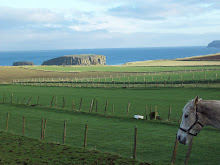
After studying all of these Anglo-Irish texts, from Wilde to Banville, I'm left wondering what constitutes Irishness?
Is it the red hair and freckles (no - that's from the vikings I'm told!)?
Is it the popular social gathering place being the pub (with Guinness the pint of choice)?
Is it the ever-looming evidence of 700 years of oppression and the fight for independence?
Maybe it's the dark sense of humour or their favorite word of emphasis -Feckin' which Roddy Doyle does so well.
Is it the friendiness and the accents which differ from county to county (or even which side of the Liffey if you're in Dublin!)?
What about the question of the Irish language? Gaelic or Irish to be precise.
Yes, there is Gaelic written on all of the signs in Ireland, Irish students can't get into university without passing Irish no matter if they have straight A's in every other subject. Why are all the great Irish writers writing in English, or some even French (Beckett)? There's a simple answer, but its implications are more complex. Speaking Irish was not always encouraged in schools the way that it is today. There have been periods in history where Irish was looked down upon, if you wanted to do business you had to know English. In the West, there are are still places where Irish is the predominant language, called The Gaeltact - or Irish-speaking region.
The answer to my first question can be found in the array of styles, types of texts (plays, short stories, poems, novels) written by the authors I've read throughout the semester. Some are short and to the point, while others are very detailed. Irishness can not be defined. History has had a large impact - some element of history (even if only discreetly by Beckett) is mentioned by every single author I read this semester. Irishness is still developing, and their question of identity cannot be answered by me, simply an American who lived here for 4 months.
What I can tell you is how I compare the Irish to other European cultures I've experienced. The Irish know how to make a beer - and know that the pint is the perfect size (something the Dutch could learn - for example). You can smile freely in Ireland and not have to worry that someone will take it the wrong way (unlike in Austria where to smile at someone means you're interested!). You can talk to anyone for directions and most people will go out of their way to make sure you arrive at your destination. If you go to the pub with a local and just meet them - they will insist on buying you a pint no matter how much you protest - it's just the Dublin way of saying "Failte." Once you get used to one accent - good for you! One down, about 26 to go - one for each county (nevermind the 6 counties in the North)! Those are just some of the things I've noticed in my time here, and they've made me love the Irish.





